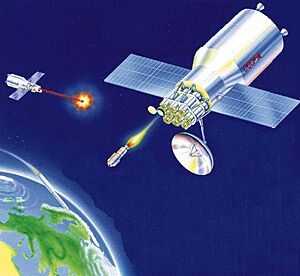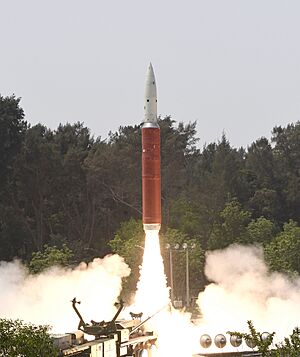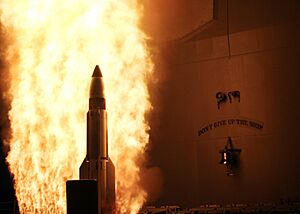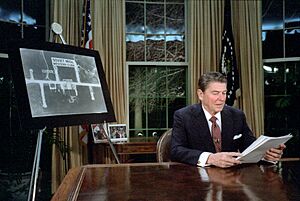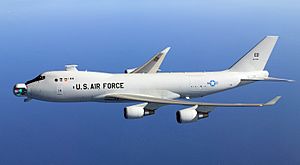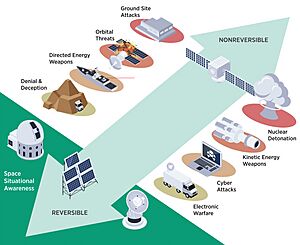Space warfare facts for kids
Space warfare is when countries use special tools and technologies to fight or protect their important equipment orbiting our planet. This can mean attacking satellites from the Earth, satellites attacking other satellites, or even satellites aiming at targets on Earth. Countries have made agreements to try and keep space peaceful and prevent dangerous weapon systems, especially very powerful ones, from being placed there.
Recently, there have been real-world examples of this. In late 2023, a special defense system stopped a ballistic missile high above Earth's atmosphere. This was a first-time event for a defense system working in space during a conflict. In early 2024, many similar missiles were launched, showing how these space-related technologies are being used.
Many countries have special military groups focused on space. For example, the United States Space Force is America's main military group for space. Russia also has its own Space Force. In 2019, India tested a special missile that can hit satellites, becoming the fourth country to show this ability. Soon after, India created its own Defence Space Agency to handle space defense.
Contents
History of Space Defense
Early Ideas (1950s)
In the 1950s, during a time called the Cold War (when the USA and the Soviet Union were rivals), countries wanted to gather information safely. Before satellites, they used special planes like the American U-2 spy plane. This plane could fly very high, making it hard for others to reach. However, in 1960, a U-2 plane was shot down by a missile, showing that even high-flying planes weren't completely safe.
Then, in 1957, the Soviet Union launched Sputnik 1, the first artificial satellite, into space. It was too high for any weapons to reach! Even though Sputnik 1 was just sending radio signals, its launch started the Space Race. Both the United States and the Soviet Union began working hard to send more things into space and also started thinking about how to use space for defense.
Space Weapon Development (1960s)
In the 1960s, countries first thought about fighting in space by having satellites attack other satellites. The Soviet Union started the Almaz project to inspect and destroy satellites. The United States had a similar idea with the Blue Gemini project, using modified spacecraft to carry weapons and watch other objects in space.
In 1962, the United States did a test called Starfish Prime. They set off a special device in space to see what would happen. It created a powerful energy burst that caused many satellites to stop working. Because this was so harmful and hard to control, countries later signed the Outer Space Treaty in 1967. This agreement banned powerful weapons from being placed in space.
Around the same time, the U.S. military even made a film about space warfare called Space and National Security.
From the 1970s to 1990s
In the 1970s, the Soviet Union kept working on space defense. They even tested a cannon from a space station! This test was done when no one was on board, to keep astronauts safe.
In 1976, there were ideas that the American Space Shuttle might be used for military purposes, like carrying special equipment. However, its main design was for deploying or picking up objects in orbit.
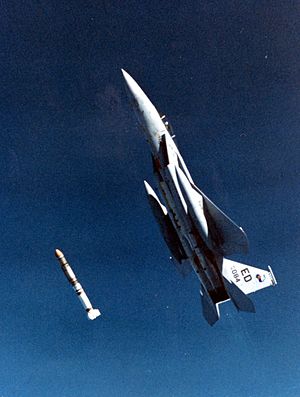
Both the Soviet Union and the United States created anti-satellite weapons to shoot down satellites. In the 1980s, the U.S. developed ground-based lasers that could target satellites. Today, these specific military laser systems are not known to be active. But, a weaker version of these lasers is used by scientists to help telescopes see stars more clearly.
In 1984, the U.S. proposed a big defense plan called the Strategic Defence Initiative. People nicknamed it Star Wars because it sounded like something from the movies!
In 1985, the United States showed its ability to destroy satellites. An F-15 jet launched a special missile called an ASM-135 ASAT to shoot down one of its own research satellites, the Solwind P78-1, orbiting high above Earth.
Space Defense Since 2000
Since the year 2000, more countries have developed space defense abilities. On January 11, 2007, China successfully tested a missile that could destroy satellites. This test caused concern from other countries.
The U.S. developed a missile called the SM-3. They tested it by hitting targets in space. In 2008, the U.S. used an SM-3 missile to destroy one of its own spy satellites, USA-193, high above the Pacific Ocean. Japan also uses the SM-3 missile. There have been talks about placing land-based versions in other countries too.
In March 2019, India used an ASAT missile to shoot down a satellite in low Earth orbit. This operation, called Mission Shakti, showed India's ability in space defense. Soon after, India created its Defence Space Agency and held its first practice exercise for space warfare.
In July 2019, France's leader, Emmanuel Macron, asked for a special space command to protect France's satellites. The French Defense Minister, Florence Parly, announced plans for new space defense tools. These ideas include using tiny nano-satellites to patrol, ground-based lasers to temporarily disable other satellites, and even small weapons on satellites for protection.
Starlink, a large group of satellites from SpaceX, became very important for communication during a recent conflict. When other communication systems had problems, Starlink helped people stay connected. It was even used with drones and sea drones. SpaceX, the company, tried to limit its use for direct fighting. There were also concerns about attacks on Starlink satellites.
On October 31, 2023, a missile was stopped by Israel's Arrow 2 defense system. This happened high above Earth's atmosphere, making it the first time such an event was recorded in space during a real-world situation.
More recently, in late 2024, a new type of intermediate-range ballistic missile was used in a conflict. This missile was special because it could release multiple smaller parts, hitting different targets. This event showed new ways that advanced missiles are being used.
It's often hard for countries to know exactly what other countries are doing in space. They rely on public statements and agreements to understand each other's plans for space defense.
Types of Space Weapons
A counterspace attack means trying to stop another country from using space for things like communication or defense.
Ballistic Weapons
From the late 1970s to the 1980s, the Soviet Union and the United States imagined and even tested different kinds of space weapons. They thought about using space to defend against or attack missiles on Earth. However, the Outer Space Treaty stopped them from putting very powerful weapons in space. The U.S. also looked into using space-based lasers to stop ballistic missiles, realizing these missiles were fragile and lasers could reach far.
Ideas for these systems included anti-missiles, railguns, space lasers, and even orbital mines. These were seriously considered in the 1980s as part of the Strategic Defense Initiative, also known as Star Wars. While the U.S. developed some working models, like powerful lasers, they needed too much energy to be practical. Many people also worried that these weapons would make the Cold War more dangerous.
Electronic Warfare
After the Cold War, as satellites and electronics improved, space became important for regular military actions. Today, military activities in space mostly involve using satellites for spying, communicating, and finding locations. They also involve ways to stop an opponent from using their own satellites for these purposes.
So, many space 'weapons' are designed to block, damage, or destroy enemy satellites, and to protect friendly ones. The U.S. and other countries are looking into small, fast satellites called 'microsats' (like a refrigerator) and 'picosats' (about the size of a small box). These tiny satellites could move around other objects in space to fix things, or even to bump into or disable enemy satellites.
Kinetic Weapons
Kinetic weapons work by hitting their targets very hard. In space, these could be missiles launched from Earth or weapons fired by satellites already in orbit.
One idea is to use kinetic weapons from space against targets on Earth. While treaties stop powerful weapons from being in space, other types are less regulated. Since the 1950s, the U.S. has thought about kinetic bombardment. This means having non-explosive objects orbiting Earth that could be dropped onto targets. Because these objects would fall from space, they would hit with incredible force, like a very powerful explosion, without needing any actual explosives.
This kind of system would need a 'spotter' satellite to find targets and another satellite to drop a heavy, needle-like dart made of tungsten. This could be very effective against large targets. While this idea is popular in science fiction, there's no public proof that any country has built such a system.
Directed-Energy Weapons
Directed-energy weapons use focused energy, like lasers, microwaves, or particle beams. Particle beams shoot tiny particles at super high speeds to cause damage. Most of these are still ideas or too hard to build right now, except for lasers. Lasers have been used to temporarily disable satellites and are starting to be used on Earth. These weapons work better in space because there's no air to scatter the energy. During World War II, there was even an idea for a 'sun gun' – a giant mirror in space to focus the sun's energy.
In space, directed-energy weapons can be 'high-powered' or 'dazzlers'. High-powered lasers aim to permanently damage sensitive parts of satellites, like cameras. 'Dazzlers' are meant to temporarily disable a satellite without destroying it. It's often hard to tell who used these weapons or if they worked. Countries like the United States, China, Russia, and France are all working on these types of technologies.
Challenges of Space Warfare
Fighting in space would involve huge distances and incredibly fast speeds, much more than on Earth. These vast distances make it very hard to aim and track targets. Even light takes a few seconds to travel across space. So, if you're trying to hit something far away, you're seeing where it was a moment ago, not where it is now. This makes aiming very tricky, even for fast lasers. A projectile from a railgun would take many hours to travel a long distance in space!
Hitting targets in space is hard for three main reasons. First, tiny aiming mistakes can lead to missing by thousands of kilometers. Second, objects in space move incredibly fast; a satellite in low Earth orbit travels about 8 kilometers per second! Third, even though space is huge, satellites are quite small. The International Space Station is over 100 meters wide, but many satellites are only a few meters. Also, powerful energy weapons need a lot of electricity, which is hard to generate enough of in space with current technology. For example, a project called Project Excalibur to create powerful space lasers was stopped because it didn't work well.
Experts like General William L. Shelton say that knowing what's happening in space is more important for protecting satellites than just making them stronger. The Air Force Space Command focuses on having many smaller, spread-out satellites, so one attack can't take down everything.
Space Debris
Attacks on satellites, especially those that hit and break them, create space debris. This debris can stay in orbit for years and might crash into other satellites, causing even more debris. This is called Kessler syndrome, where collisions create more collisions, making space very messy and dangerous for future missions.
For example, in 2007, when China destroyed a satellite, it created over 40,000 new pieces of debris. Because of this problem, countries are now trying to develop 'soft-kill' methods, like jamming signals or temporarily blinding satellites, which don't create as much space junk.
Space warfare can be risky for astronauts in space, for companies that use satellites, and for launching new things into orbit. Countries that fight in space might also face criticism for breaking the 1967 Outer Space Treaty, which aims to keep space peaceful.
Protecting Space Assets
Many of our daily activities, like using phones or the internet, depend on satellites. So, countries want to protect their satellites, which might lead them to develop more space weapons, especially if they are advanced in space technology.
Since 2017, the United States Air Force has held yearly practice drills called "Space Flag." In these drills, a 'red team' pretends to attack U.S. satellites to help prepare defenses.
Robert Zubrin, an aerospace engineer, believes that as countries get better at anti-satellite weapons, our space systems must be able to defend themselves. Otherwise, important things like GPS, phone calls, and spying from space could be easily stopped by opponents.
Direct Ascent Weapons
Direct-ascent anti-satellite weapons are like modern versions of the ASM-135 ASAT. These are usually missiles launched from Earth that fly directly up to hit a satellite. So far, four countries (the USA, China, India, and Russia) have shown they can launch these, but none have used them against another country's satellites yet.
These direct-ascent weapons use existing missile technology. They can be very destructive and create a lot of space debris, which can harm other satellites. While they offer a surprise element, they are expensive to use against smaller satellites. Also, they can only reach satellites in low Earth orbit and only in a certain area.
Co-Orbital Weapons
Co-orbital systems involve satellites that orbit alongside other satellites. These systems might use small guided vehicles or release a cloud of debris to disable a target. The Soviet Union developed the first co-orbital system, Istrebitel Sputnikov, in the 1970s.
Some reports suggest that Russia continues to test co-orbital anti-satellite weapons. For example, in 2020, a Russian satellite, Cosmos-2519, released a smaller satellite that could fly on its own and inspect other satellites. In 2019, two other Russian satellites seemed to follow a U.S. satellite. These 'inspector' satellites could potentially use lasers to interfere or even small kinetic devices to disable other satellites.
Co-orbital systems are more flexible than direct attacks, but they need to be able to move easily and not be easily noticed. However, with growing concerns about these types of weapons, it's becoming harder for countries to hide what their 'research' satellites are really doing.
Space Warfare in Science Fiction
Space warfare is a very popular topic in science fiction stories. These stories show many different ideas, from realistic future technologies to fantasy battles in space. Sometimes, space militaries are like an air force, and other times they are more like a navy. Some stories even feature 'space marines' who fight across planets. The main types of space warfare stories are space opera, military science fiction, and Space Western. These types often mix together. Many Space Western stories come from popular space opera worlds like Star Wars and Star Trek. A famous example is Warhammer 40,000, which started as a game and now has many books and video games.
In these stories, you often see both kinetic weapons (hitting things) and directed energy weapons (like lasers), along with many types of spaceships. Lensman by E. E. Smith is an old example that helped create the idea of 'space opera'. The Ender's Game series by Orson Scott Card explores how people might train and fight in space. Other authors like David Weber and Larry Niven have also written about space combat tactics. Starship Troopers by Robert A. Heinlein is famous for its idea of 'space marines'.
You can see space battles in many movies and video games, like Star Wars, Halo, Gundam, and Star Trek. Games like Homeworld show cool ideas for space warfare, such as fighting in 3D space and using energy weapons. Other series, like Gundam, show battles around future space habitats like O'Neill cylinders.
Many fictional galaxies feature space warfare, including Star Trek, Star Wars, Halo, Stargate, and Warhammer 40,000. Video games like Wing Commander also explore this topic. While most games don't show realistic distances and speeds, some, like Independence War, try to.
Many authors have either used a galaxy-spanning fictional empire as background or written about the growth and/or decline of such an empire. To make interstellar war possible, science fiction writers usually imagine some kind of faster-than-light travel. Some writers, like Larry Niven, have even created realistic stories about conflicts between humans living on asteroids and other planets, using technologies that follow what we know about physics today.
See also
- Asteroid impact avoidance
- Beijing–Washington space hotline
- Militarisation of space
- Schriever wargame
- Space force
- Space weapon
- Sun outage


